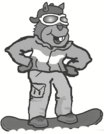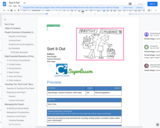
This infographic provides questions that parents can ask schools about their child's reading skills.
- Subject:
- English Language Arts
- Material Type:
- Diagram/Illustration
- Provider:
- National Center on Improving Literacy
- Date Added:
- 12/14/2023

This infographic provides questions that parents can ask schools about their child's reading skills.

Infographic and teachers guide about teaching the requirements to be eligible to run for US president, the elections process, and obstacles in the candidacy process.

This informational text introduces students to the life cycle and migration of the sanderling, a bird that winters on beaches in the Southern United States and South America but breeds in the Arctic during the summer months. The text is written at a grade two through grade three reading level. This version is a full-color PDF that can be printed, cut and folded to form a book. Each book contains color photographs and illustrations.

This informational text introduces students to the life cycle and migration of the sanderling, a bird that winters on beaches in the Southern United States and South America but breeds in the Arctic during the summer months. The text is written at a kindergarten through grade one reading level. This version is a full-color PDF that can be printed, cut and folded to form a book.

This animation adapted from NASA shows the orbital paths of spacecraft in NASA's Earth Observing Fleet that are a source of wide-scale, primary research about Earth.

School librarian Marcia Mardis describes what the library can offer to teachers and students who want to produce a focused, engaging, and effective science fair. This article appears in the free online magazine Beyond Weather and the Water Cycle, which explores the seven essential principles of the climate sciences for K-grade 5 classrooms.

An original informational story about Sun's role in heating Earth's air, land, and water and Sun's connection to the seasons and weather. The story encourages young readers to observe Sun's impact on weather and the seasons and to make predictions about the weather. The story is available in separate versions for grades K-2 and 3-5 and as a downloadable, full-color pdf. The story is a feature of the free online magazine that focuses on the seven principles of climate literacy.

An infographic that shows all of the benefits of sharing materials for teachers who are not sure if they want to share

This informational text introduces students to solar energy's role in warming the Earth's land and water and to the fact that dark-colored surfaces absorb more of the Sun's energy than do light-colored ones. Students also read about how the decline in Arctic sea ice is changing Earth's energy balance. This version is a full-color PDF that can be printed, cut and folded to form a book. Each book contains color photographs and illustrations. The text is written at a grade four through grade five reading level.

This slide deck demonstrates how teachers can use the Seesaw platform to document student learning. The presentation will walk teachers through the process of developing digital learning and capture student learning over time.

In this adapted ZOOM video segment, cast members calculate how much water they each use during a typical shower. They compare their results to their original predictions.

Background image of normal disc-shaped red blood cells from the University of Utah. Inset shows sickled red blood cells, curved and rigid, from the Virginia Medical College.

Infographic about the different roles of president as defined by the US Constitution.

Science Phenomena: HS Physical Science - Forces and Interactions (Phys 1.3, 2.3, 2.4) - In this dramatic slow motion video a golf ball collides with a piece of steel showing a large amount of compression. Different golf balls are designed to have varying amounts of compression based on the desired behavior of the ball. In a kindergarten class golf balls or baseballs are great examples of pushes causing changes in the motion of an object. In the upper grades this could be a great example of a collision. Students could investigate the behavior of different golf balls (or clubs) and even do some designing themselves.

This video segment adapted from NOVA/FRONTLINE looks at American energy consumption and the resulting production of greenhouse gases.

This resource is from the "Winter Feels Good" CD-ROM developed by SnowSports Industries America and its partners. It includes a template for creating a snowboarding field trip flyer.

The Four Social Revolutions refers to the indentification of social change through modes of subsitance. Examines hunter-gatherers, pastoral, horticultura, agrarian, industrial, and post-industrial.

What is a solar eclipse and why are they only visible in some parts of the world? In this video segment adapted from NASA, astronomer Susan Stolovy uses animations to provide an answer to these questions.

In this video segment adapted from ZOOM, cast members assemble a solar still and make fresh water from saltwater, demonstrating two steps of the water cycle, evaporation and condensation.

In this project, students will use knowledge of electricity and electromagnetism to collaboratively design and test a model of a magnetic recycling sorter. They will evaluate the performance of their models and propose further modifications based on the output of their magnetic device measured in mT using a Vernier probe. They will also physically test their magnets on a model of a conveyor belt containing recyclable items. Students will track their data from both tests, with the ultimate goal of creating the strongest and most effective magnet with given materials. Finally, students will present their findings and proposed final design to peers and community partners involved in the recycling industry. The entire process takes about 6 weeks. The unit is a great fit for standards within energy and engineering & design.